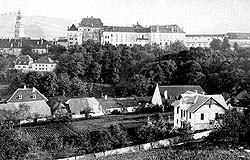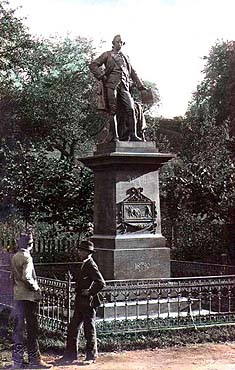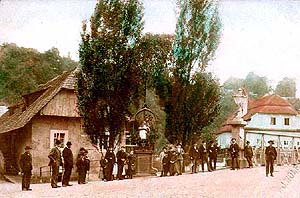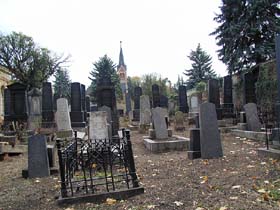The historical evolution of Český Krumlov gardens and parks from 1850 - 1939 (Historic period and modern times)
 After the closing of the
Schwarzenberg
economic institute in 1850, its exemplary garden, which was
part of Deer Garden, lost its previous function. A new seed
separation facility was built in its north-western corner where the
Jelenka restaurant is situated at present. A small new park with a
diagonal path structure was created on the garden grounds. In the
2nd half of the 19th century we observe a general deterioration in
the state of historically founded gardens. This can be seen in the
simplification of structure of the castle
garden and in the reduction of glasshouses in manorial gardens
around 1870. Novoměstka
garden was completely closed and the garden grounds were rented
to private individuals. The gardens on the town's edge gradually
began to vanish while newly emerging production and factory
buildings were built in their place.
After the closing of the
Schwarzenberg
economic institute in 1850, its exemplary garden, which was
part of Deer Garden, lost its previous function. A new seed
separation facility was built in its north-western corner where the
Jelenka restaurant is situated at present. A small new park with a
diagonal path structure was created on the garden grounds. In the
2nd half of the 19th century we observe a general deterioration in
the state of historically founded gardens. This can be seen in the
simplification of structure of the castle
garden and in the reduction of glasshouses in manorial gardens
around 1870. Novoměstka
garden was completely closed and the garden grounds were rented
to private individuals. The gardens on the town's edge gradually
began to vanish while newly emerging production and factory
buildings were built in their place.
 A large building housing
stock beer cellars was built on the grounds of the former monastery
gardens in 1867. On the ground of the Jungbaer brothers' former
textile factory in the Budějovicka town district (presently under
the Ambit company), the Porák brothers founded a graphite
processing factory. A regulatory plan from 1896 shows that the
entrance space in front of the factory was laid down as a park in
historical style with a Baroque path net. There was a circular
fountain at the park's centre.
A large building housing
stock beer cellars was built on the grounds of the former monastery
gardens in 1867. On the ground of the Jungbaer brothers' former
textile factory in the Budějovicka town district (presently under
the Ambit company), the Porák brothers founded a graphite
processing factory. A regulatory plan from 1896 shows that the
entrance space in front of the factory was laid down as a park in
historical style with a Baroque path net. There was a circular
fountain at the park's centre.
Many memorials were built in Cesky Krumlov in the late 19th century and at the beginning of the 20th century. Many of these were destroyed or damaged. On 20th July 1890, a memorial to the Emperor Josef II was unveiled on the right bank of the Vltava river, near the present School of St. Agnes. The memorial is situated on one end of the bridge near a shooting range surrounded with a symmetrical garden. At the anniversary of the 50 years' reign of Franz Josef I, a memorial was unveiled in Horní brána near a road leading to Rozsyp in 1898. This memorial commemorated the braveness of the citizens of Česky Krumlov who lost their lives in the war between Prussia and Austria in 1866. A garden was made in its surroundings.
Thanks to regulatory plans developed by A. Nenninger in 1895-1896, we have a wealth of information about the late 20th century urban structure of the town and its green areas in relation to the town estate. Plans prove existence of many burgher gardens which consisted of both vegetable and decorative parts. The latter was mostly laid down in a regular historical style.
 A typical feature of such
a garden was a crossing of paths in which a round flowerbed or a
round water reservoir was situated. The regulatory plan describes a
set of those gardens near houses in Linecká street. Gardens in
lower Plešivec and the Budejovické town district were designed in a
similar way. At present, the only example of such burgher gardens
is a wild garden near the house no. 147 at Latrán.
A typical feature of such
a garden was a crossing of paths in which a round flowerbed or a
round water reservoir was situated. The regulatory plan describes a
set of those gardens near houses in Linecká street. Gardens in
lower Plešivec and the Budejovické town district were designed in a
similar way. At present, the only example of such burgher gardens
is a wild garden near the house no. 147 at Latrán.
In 1892, the town's cemetery near the St. Martin's Chapel was
moved to the edge of the town near Rozsyp. A Jewish cemetery was
founded behind it in 1895. The regulatory plan explains the
allotment of new cemeteries as well as a proposal of compositional
structuring of the new park between the Roman-Catholic cemetery and
the road leading to Rozsyp.  Around 1900, a playground
was established between a summer swimming pool and the St.
Martins's Chapel. The former Jesuit garden was opened to the
public, though the garden was not yet structured. In 1907, a
town
park was founded here thanks to the mayor, Frank Khemeter. This
newly founded park was ceremonially opened on 16th June 1907 and
later tended to by a town gardener. A redesign project of the
garden was worked out by a municipal construction bureau. We do not
know who was the project inventor, but it is very likely a town
architect named Karl Nowaczek.
Around 1900, a playground
was established between a summer swimming pool and the St.
Martins's Chapel. The former Jesuit garden was opened to the
public, though the garden was not yet structured. In 1907, a
town
park was founded here thanks to the mayor, Frank Khemeter. This
newly founded park was ceremonially opened on 16th June 1907 and
later tended to by a town gardener. A redesign project of the
garden was worked out by a municipal construction bureau. We do not
know who was the project inventor, but it is very likely a town
architect named Karl Nowaczek.
The former ground of the Jesuit garden was enlarged by the ground of the former cemetery. The south-eastern part of the park was intended mainly for sport activities. In 1910, a memorial to Friedrich Ludwiga Jahn (1778 - 1852), a founder of German physical training movement, was unveiled in the northern part of the park. Sometime around 1924 - 30, the park's composition was altered. A public canteen and a visiting room for those suffering from tuberculosis was built near the St. Martin's Chapel. A wooden pavilion was built near the Jahn memorial and then the path network was changed. A main central path through which the inner path circle closes was added. The town park was given a sense of piety with the unveiling of a memorial to the victims of WWI in 1930.
Further information:
- The historical evolution of Český Krumlov gardens and parks in the 14th and 15th centuries (Gothic period)
- The historical evolution of Český Krumlov gardens and parks in the reign of the last Rosenbergs (Renaissance and Mannerism period)
- The historical evolution of Český Krumlov gardens and parks under the administration of the emperor in the years 1601 - 1622 (Mannerism period)
- The historical evolution of Český Krumlov gardens and parks in the period of the reign of the princes of Eggenberg in the years 1622 - 1719 (Mannerism period and the beginnings of the Baroque)
- The historical evolution of Český Krumlov gardens and parks in the reign of the first two generations of the princes of Schwarzenberg in the years 1719 - 1782 (Baroque and Rococo period)
- The historical evolution of Český Krumlov gardens and parks in the years 1782 - 1850 (Classic and Romantic period)
- The historical evolution of Český Krumlov gardens and parks from the year 1939 to the present


